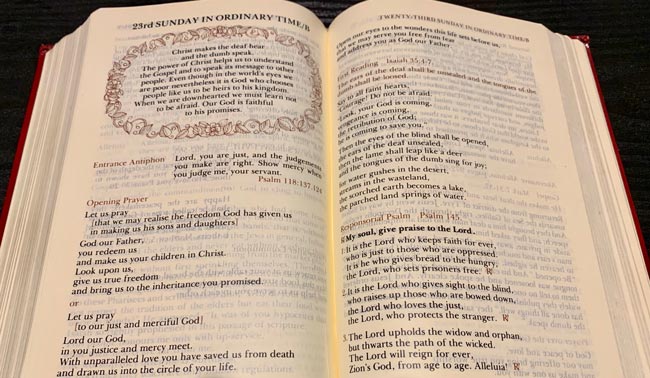Fitting readings and calendar together
We’ve looked at the pattern of the Church’s year, and at the ways the readings interlink in the Sunday liturgy. Now it’s time to look at how it all fits together over time. I hope, especially as we’ve gone through the calendar in this section, all those different Sunday names have become clearer. This is now where we deal with the last plank of all those detailed references to particular Sundays by years as well as by names.
The pattern of readings is based on organising the reading of Scripture over three years. This is done slightly differently depending on whether we are in one of the two main seasonal cycles, or are in Ordinary Time. This difference is potentially greater for the Revised Common Lectionary than it is for the Roman one. The underlying principle of the three years remains the same throughout.
Each year is based on one of the first three gospels. This is especially notable in Ordinary Time. John’s gospel is used primarily in the seasons in addition to the gospel being read that year, and as a supplement to the shortest gospel, that according to Mark. There are a number of readings from John 6, for example, in the summer months of Year B, before the reading of Mark is resumed.1 That means we have a year when Matthew is being read (Year A), a year of Mark (Year B) and that we read Luke in the last year of the cycle (Year C).
When a key event in the calendar is commemorated in all three synoptics, then it is quite easy to use the account from that year’s gospel. So, for example, for the Baptism of the Lord, we read from Matthew in Year A, Mark in Year B, and Luke in Year C. However, there are some occasions when the story of the event we are commemorating does not appear in all the gospels. When the church celebrates Candlemas, the Presentation of the Lord, the only gospel that has the story is St Luke’s. Therefore, whether year A, B or C, the reading comes from Luke.
In Ordinary Time, things are a little less coherent. In the Lectionary for Mass, and as one of the options in the Revised Common Lectionary (which is based on it), the Old Testament reading is chosen to relate to the Gospel. These two readings are therefore always connected in some way. In the ecumenical lectionary this is called the related pattern of readings, and is provided as the second track or list of readings. We will come to the alternative after looking at what happens with the New Testament reading.
In both lectionaries, the Ordinary Time readings from the letters or the Apocalypse come in semi-continuous sequence. The letters are not read through in their entirety: to do that would make the readings either too long, or mean they needed to be read over a longer cycle. But key passages from the letters are read, in the order in which they appear in that book of the Bible. Broadly speaking, the argument of a particular letter is read through over several Sundays.
This semi-continuous pattern of reading means that the second reading often bears no obvious relation to the other two in Ordinary Time. That doesn’t mean a preacher won’t look for, and with varying degrees of success, find links between them. It does mean that you as a reader don’t have worry about your understanding of the reading when you can’t find a link yourself. You’re not missing the point; there simply isn’t a point to be found!
This brings us to the single biggest change the Revised Common Lectionary makes to the Lectionary for Mass. It provides an alternative set of Old Testament readings in Ordinary Time to the ones we’ve already discussed. This pattern is listed as the first track, and labelled continuous. These, like the New Testament readings, are arranged in a semi-continuous sequence.
These readings are often longer than the related ones. They are also entirely unconnected to the other readings, and those churches which follow the continuous track therefore have three quite independently chosen readings through Ordinary Time, even if a slightly larger spread of Scripture is read. In fact, quite a number of the stories in the continuous pattern of readings also occur in varying places in the related pattern.
Churches which have this choice need to weigh their options very carefully. Following the continuous track means more scripture is read, but that none of the readings are connected. In my view, that means that while more might be read, less might be understood. For some, that risk is worth taking. What should be avoided at all costs is doing one thing one week, and something different the next. Let the church pick one pattern, and stick to it for at least one whole three-year cycle.
You now have all the information you need to understand the descriptions used of any particular Sunday in the lectionary. We have looked at the seasons, at ordinary time, the numbering of the Sundays, and now the three years of the lectionary. You have what you need to decode a sentence like: it’s the 23rd Sunday of Ordinary Time, Year B (as illustrated in the photo).
Notes
- In the final section, software, looking at the books of the Bible, we
will take a closer look at each of these gospels. Briefly, the first
three gospels are called synoptic gospels. Synoptic means something like
“with a single eye”, because we can look at them together and see a
recognisably similar story, often in very similar words.





Comments
Post a Comment